River Serpent
This venue was located on the second floor of the clubhouse of the Minnesota Boat Club, 1 Wabasha Street, Navy Island, under the Wabasha Bridge in St. Paul.
NAVY ISLAND
The original name of the island where the River Serpent was located was Raspberry Island, named for the wild raspberries that grew there; the name appeared on the first map of downtown St. Paul in 1851.
The name Navy Island came from the fact that the U.S. Navy built a small base on the eastern side of the island, which was used between 1949 and 1968.
William A. Levin says:
This base used by the Coast Guard Auxiliary during WWII. Liberty Ships were being built at Port Cargill in Savage, and B-24s were being outfitted at Holman Field in St. Paul. Therefore the Coast Guard used volunteers to patrol stretches of the Mississippi and Minnesota Rivers for saboteurs. My grandfather, David S. Levin, was one of many Coast Guard volunteers. He felt he had to do something to support the war effort and his two sons in the Navy in the Pacific. He would have about age 55.
The west side of the Island was owned by the Minnesota Boat Club.
In 1995 the St. Paul City Council passed a resolution changing the name back to Raspberry Island.
As it was literally an island on the Mississippi River, it was prone to flooding, and several times it was cut off from the mainland. A couple of venues somehow tried to keep running, even without access, which is part of the fun of this story.
THE MINNESOTA BOAT CLUB
The Minnesota Boat Club was founded in in 1870 with ten members, including brothers John and Charles Corning, who had come to St. Paul from Brooklyn in the late 1860s. By 1885, the Club included the elite of St. Paul, including budding architect Cass Gilbert, who would design the Minnesota State Capitol and the U.S. Supreme Court Building; Lucius P. Ordway, head of 3M Corp.; and William Merriam, the Governor of Minnesota in 1889.
The first boat house was a floating affair, prone to leaking and threatening to sinking. Rowing became a national craze by 1870. A more substantial boathouse was completed in 1874. The current boathouse was built in 1910 and was placed on the National Register of Historic Places in 1982. But as other sports grew more popular in the late 1800s, the Boat Club fleet fleet fell into disrepair. (Curt Brown, Star Tribune, August 29, 2021)
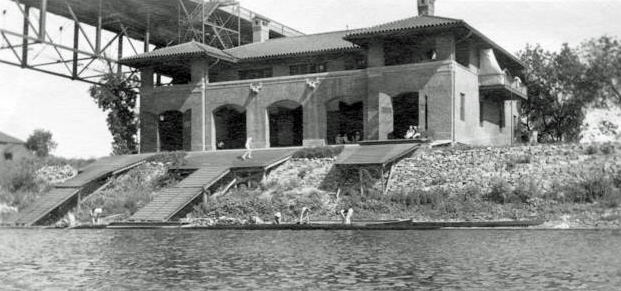
Minnesota Boat Club, 1915. Image courtesy Minnesota Historical Society
TUGBOAT ANNIE’S
Tugboat Annie’s was alternately described as a restaurant, bar, and sometimes nightclub. Will Jones, the Minneapolis Tribune columnist who tells all, informs us that the establishment opened in December 1950, and that it was run by Harold McEvoy, “who also owns a couple of breweries.”
Jones helpfully also tells us that the space had been the Minnesota Boat Club’s locker room, but interest in regattas has been lagging, so the Boat Club planned to remodel the ground floor to include their locker rooms. McEvoy joked, “Yeah, we’ve got an oarhouse downstairs.”
McEvoy used the terrace on nice days, and in May 1951 had plans to install a beer garden and barbeque pit on the west end of the Island. (Minneapolis Tribune, May 8, 1951)
The ad below was run several times, and always the same.
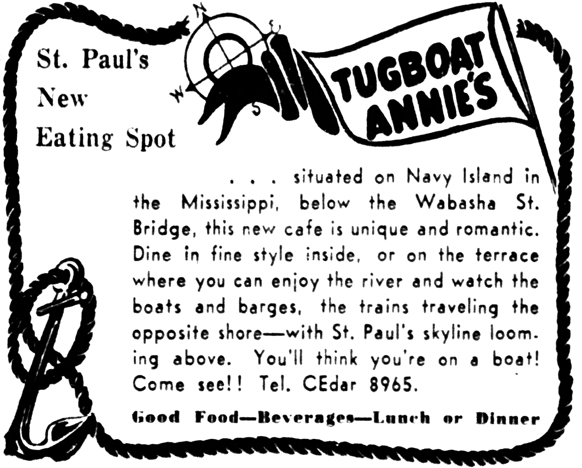
Minneapolis Tribune, August 16, 1951
Annie’s Needs a Tugboat
The first of the big floods that affected venues on the Island occurred in April 1952, but the Minneapolis Tribune reported that it hadn’t stopped business; in fact the restaurant was capitalizing on the situation with a sign on the roof telling patrons that it was a great place to get a look at the flooding river. Access to Annie’s was made by an iron stairway and across a small iron bridge. The bar sold a “flood cocktail” – just plain water.
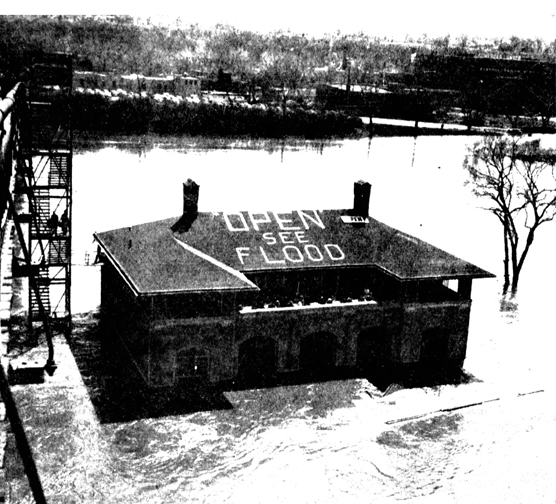
Minneapolis Tribune photo by Paul Presbrey, April 17, 1952
Trouble at Annie’s
To prevent inflation during WW II and the Korean War, in 1942 President Franklin D. Roosevelt created the Office of Economic Stabilization. Within that organization was the Office of Price Stabilization (OPS), which set maximum prices that could be charged for certain items. One of those items was beverages at cafes, and Harold McEvoy was accused of overcharging for drinks and not keeping proper records by the OPS. In January 1953, the office filed an injunction seeking treble damages of almost $43,000 for overcharges amounting to over $14,000. The injunction prevented McEvoy from doing business until he complied with the OPS record keeping requirement and reduced his drink prices.
Then in June 1953, the IRS tacked on a tax lien on McEvoy’s properties, seeking over $3,000 due in withholding and employment taxes from September 1952 to June 1953. Previous liens from 1952 totaled more than $100,000; apparently McEvoy owed a boatload of taxes for 1945, 1946, and 1949. All of his properties had been seized, and the Government auctioned off the furnishings and supplies of Tugboat Annie’s in July 1953. I hope he had fun while it lasted.
INSIDE ANNIE’S
That should have been the end of Tugboat Annie’s, but a photo just came up on Facebook showing the “Bar at Minnesota Boat Club,” 1960. There were no more ads I could find, but maybe someone else took it over? Maybe the Boat Club itself? Maybe it’s just misdated? At any rate, thanks to Michael Larkin for finding it, and to Jen Conner for noticing the “writing on the wall” that I missed!
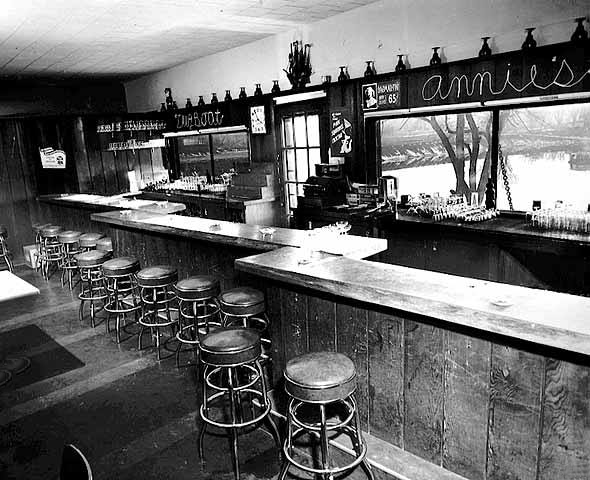
Photo courtesy Minnesota Historical Society
Harold Francis McEvoy
This nefarious behavior on the part of our friend Harry made me curious, so I did a little sleuthing on him. It appears that he was born in 1907 in St. Paul, the eldest of six sons. He served for 18 months in the Army during World War II (1942 – 1943) and was discharged as a CP1. He died in 1965 at the age of 58.
He had been in trouble before. In 1945 he bought the Hartig Brewery in Watertown, Wisconsin. In 1946, the US District Attorney announced that 1,703 cases of his beer were destroyed because the FDA declared that it was adulterated by a type of acid resulting from the use of molasses.
In 1947 he was arraigned in US District Court for criminally violating the war food order from June 1 to August 31, 1946. The complaint was that the Hartig brewery used more grain and syrup in making beer than permitted under its quota. McEvoy’s only defense was that he bought the syrup under the impression that it was molasses, which is not subject to the limitations of the food order, and used extra grain when some mash was spoiled in an accident in the brewery. But the assistant US Attorney said accused McEvoy of falsifying records and making an elaborate effort to obscure the violation. McEvoy was personally fined $3,000 each on two counts each, and the company was fined $1,000 for each count.
Then, in January 1948, described as the “former owner and manager of the Hartig Brewery,” McEvoy was fined $150 in Madison Federal court for shipping adulterated beer in interstate commerce. McEvoy pleaded no contest. The beer was adulterated by use of a “short cut” that was used by some brewers to avoid the expense of pasteurization. The brewery was in bankruptcy at the time, and the judge assessing the $150 fine took into consideration the $48,000 McEvoy had spent trying to correct “deplorable” conditions at the brewery after he bought it in 1945 and the $6,000 fine he had paid for the 1947 violations.
Oh no. In February 1948 a Federal court fined him another $2,500, after he pleaded guilty to concealing 102,180 pounds of grains spirits which he had marked as molasses back in 1946. He was given 90 days to pay the fine.
And in 1949, in the mess of bankruptcy, the receiver of the Hartig Brewery sued McEvoy and others for alleged fraud in connection with the purchase of the brewery from the members of the Hartig family back in 1945.
But hey, let’s charge ahead and open a restaurant!
THE GOLDEN GARTER
On October 31, 1961, Will Jones announced that Tugboat Annie’s had been taken over by new owners and renamed the new 3.2 bar the Golden Garter. It was redecorated with a red and gold interior with a mixture of touches from the 1890s to the 1920s.
It will be a kind of place where customers are encouraged to sing and to throw peanut shells on the floor. The place will be co-managed by Phil Greenberg, Minneapolis clothier, and Ken Wingard, a St. Paul fuel oil man, who have done much of the work on the place themselves.
The Golden Garter opened on November 3, 1961.
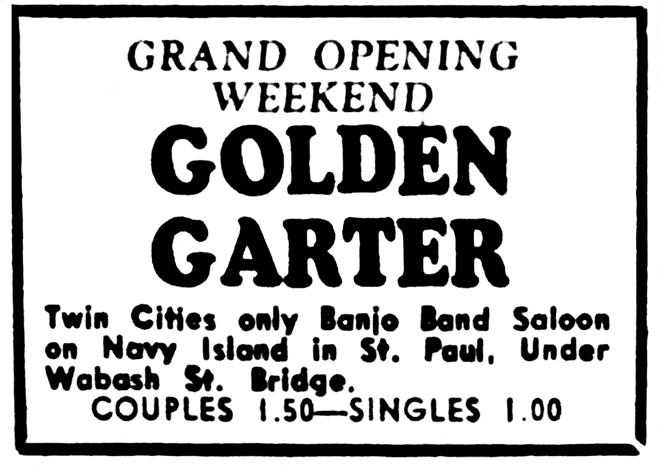
Minneapolis Star, November 3, 1961
The Minneapolis Daily Herald, which took over when the Star and Tribune were on strike in mid-1962, filed this report on June 28, 1962:
It’s New Year’s Eve every Friday and Saturday night at the Golden Garter… At midnight the noisemakers are passed out, the lights are dimmed as Dave Wesley and his Levee Loungers strike up “Auld Lang Syne” on their banjos. According to owner Phil Greenberg, the place has been jumping since they opened the doors last November. And though they’re open only four nights a week (Thursday-Sunday), the folks who join in the sing-alongs and devour 35-45 pounds of salted-in-the-shell peanuts each night also sip enough 3.2 beer to make the Garter’s weekly total consumption of suds one of the top in the state. To induce the boys to go where the girls are, and vice versa, tonight, and every Thursday is lady’s night, with no cover charge for the gals.
The Levee Loungers Make a Record
Vic Burton, Night Beat, Minneapolis Daily Herald, July 23, 1962: [Vic was a good reporter, but repeatedly referred to the Golden Garter in this story as the Red Garter, which he apologized for later. The Minneapolis Daily Herald was not known for the best reportage…]
Peanuts, Brew, and the Levee Loungers: Things will be hopping this Thursday, Friday and Saturday night at the [Red] Garter in St. Paul. The Audio Fidelity recording company is cutting an album of the Dave Wesley Levee Loungers these three days, and rumor has it that the boys are set to make it big on the national scene. Audio Fidelity no longer has the Dukes of Dixieland, and the company is planning to give the [Red] Garter boys a big promotional campaign. The actual recording is being subcontracted to Dave Hersk at Gaity Studios, and Sidney Frey, president of the Lampoon, is handling the album direction. The album is set to be released Oct. 1. About 12 microphones will be used during the session, allowing not only picking up the sounds of the Levee Loungers, but also excellent pick up of the audience, since the audience in effect has a part of the show.
From Bob Murphy, Minneapolis Star, December 18, 1962:
A new LP Stereo Hi-Fi record out here is that of the Levee Loungers, who made a name for themselves at the Golden Garter in St. Paul, where the stuff was recorded with some sing-along audience participation and off-the-cuff lyrics. The bunch includes piano, drums, sousaphone, and three banjos. Remember when Mike Pingatore used to hold up the banjo section alone with the Paul Whiteman band? And how long was it that you didn’t hear a banjo played at all, except with pennies under the bridge so it would sound like a guitar? The instrument seems to have come back into its own. This material is about as subtle as a bung-starter, but it’s adept and lively.
A bung-starter is a hammer used to pound a bung (plug) out of a barrel. I had to look it up.
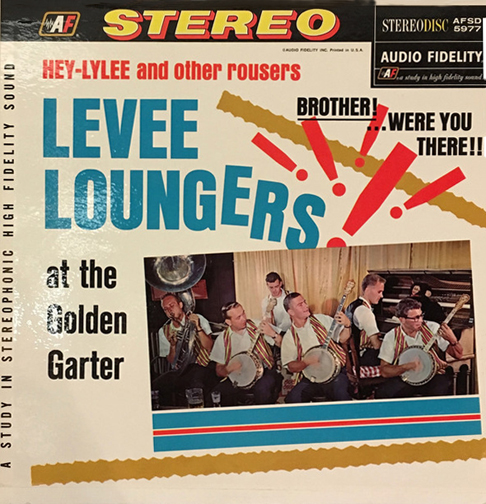
Songs on the record are:
Side 1:
- Hey Lylie
- Daisy-Sidewalks of New York
- Bill Baily
- Cotton & Corn
Side 2:
- Five Feet Two
- Heart of my Heart
- I’ve Been Working on the Railroad
- Wait ’til the Sun Shines, Nellie
- If You Knew Susie
- New Year’s Eve
Four copies of this fine recording were available for $5 plus shipping as of September 2020.
Identical, nondescript ads ran for the Golden Garter until the one below appeared in October 1962:
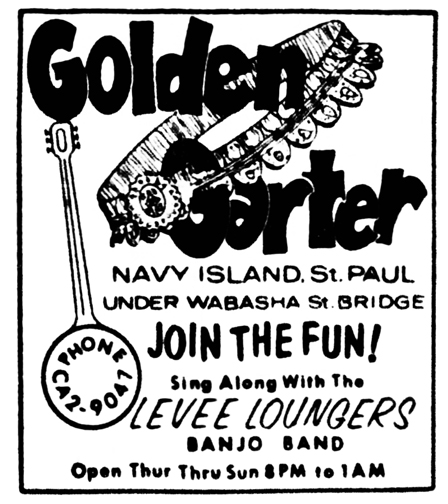
Minneapolis Star, October 19, 1962
Access Problems
Getting to the Garter was difficult enough, but in November 1962, Don Morrison of the Star reported that the Army Corps of Engineers was building a flood-control levee on the southern bank of the Mississippi River opposite Navy Island. This changed everything in terms of getting to the club.
Formerly, one stalked the Golden Garter by crossing the Wabasha bridge, turning left at its southern extremity and then turning left again down a bumpy road leading to a rude bridge that arches the flood to Navy Island. This route now will lead you smack into the levee.
In 1964, it looks like management briefly tried some of the fads,
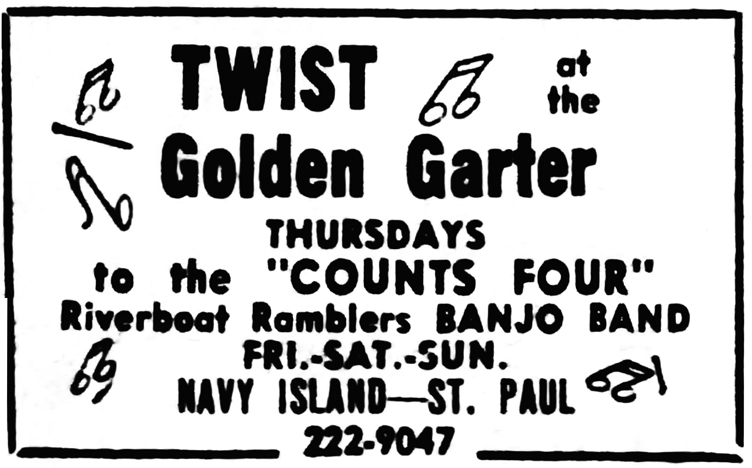
Minneapolis Star, April 9, 1964
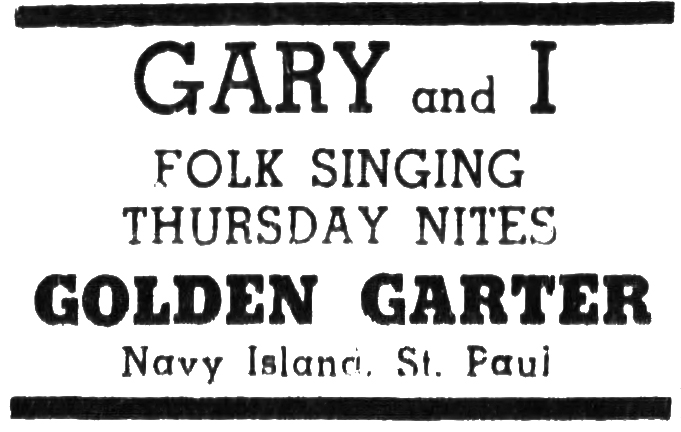
Minneapolis Tribune, November 12, 1964
… but always returned to its core audience-pleaser, jazz.
Kid Thomas Brings the (Boat) House Down
Back up to August 20, 1964, when Kid Thomas Valentine brought his “delightfully soulful New Orleans jazz” to the Golden Garter. Allan Holbert of the Minneapolis Tribune described it:
With several hundred people jammed into the Golden Garter, it was hot and sweaty before the band started playing, and the music did very little to cool things off. You could feel the place throbbing as soon as they moved into the likes of “Kid Thomas Boogie,” “Algiers Strut,” and “St. Louis Blues.”
Thomas brought only three of the musicians who were with him last summer when he played a series of concerts in the Twin Cities: Sammy Penn on drums, Manuel Paul on tenor sax and Joe Butler on bass. But four members of Minneapolis’ own Hall Brothers Band demonstrated an amazing grasp of the early New Orleans style as the augmented the quartet. They were Stan Hall, piano; Mike Polack, banjo; Butch Thompson, clarinet; and Russ Hall, trombone.
Holbert fled to the cooler Prom Ballroom to catch Count Basie, “Just before the pulsating Navy Island shook loose and began to float down the Mississippi River.”
“Navy Departs, Pub Fights On”
Such was the headline on April 13, 1965, during yet another flood, this one of catastrophic proportions. 1965 suffered record late snowfall, resulting in horrendous floods of epic proportions. As the Navy worked for three days to prepare the Naval Reserve Unit buildings on the Island against the rising waters, it became clear that the waters were going to win, and the buildings were evacuated, some by boat.
Meanwhile, at the Golden Garter, part owner Jim Drake “scrubbed down the bar with vigor, glancing nervously out a broad window at the surging stream.”
“We’ll be open till the power shuts off,” he said. Outside a painter whistled while applying huge white letters on the red roof: “Open as Usual.”
At noon three members of the four-piece band crawled out on the roof and played a set or two to let the customers know the old Golden Garter wasn’t licked yet.
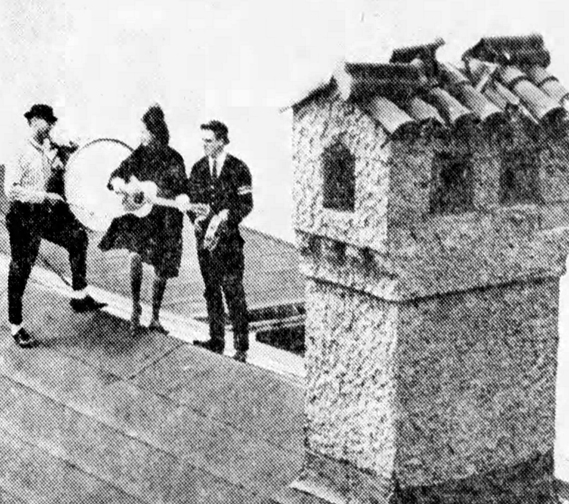
Minneapolis Star, April 13, 1965
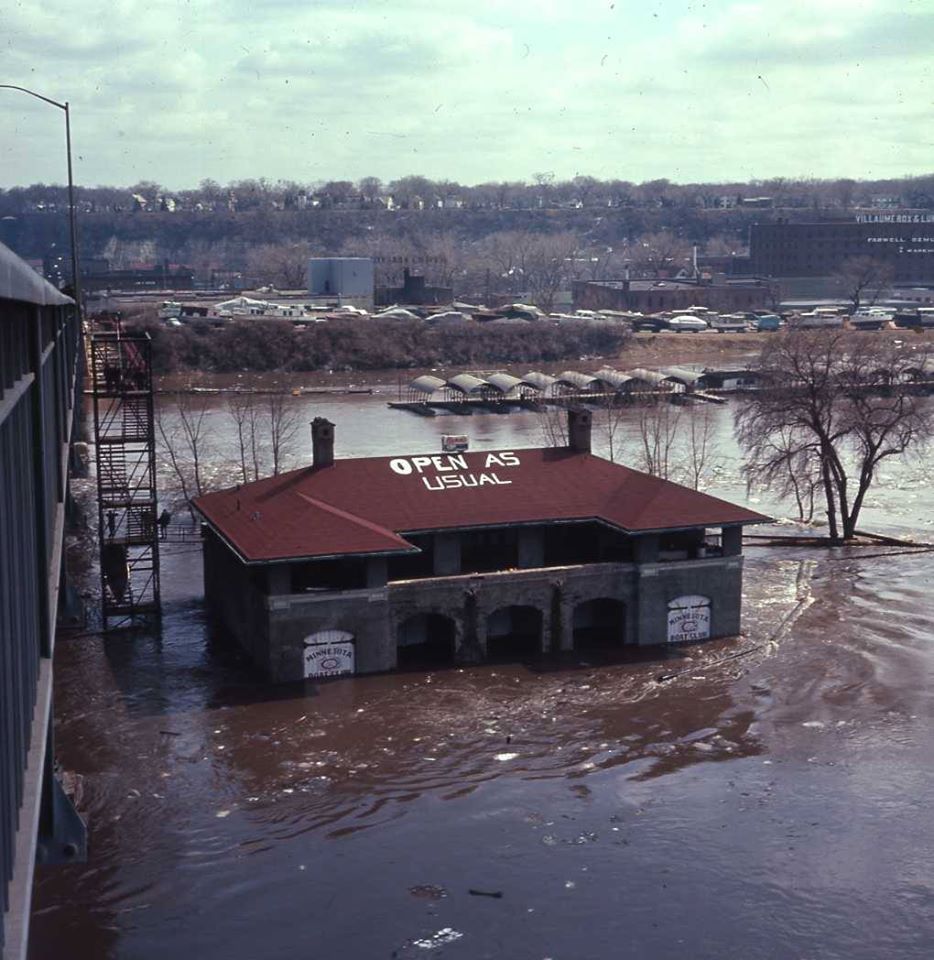
Photo courtesy Eric Larson
This was the last ad I found for the Golden Garter:
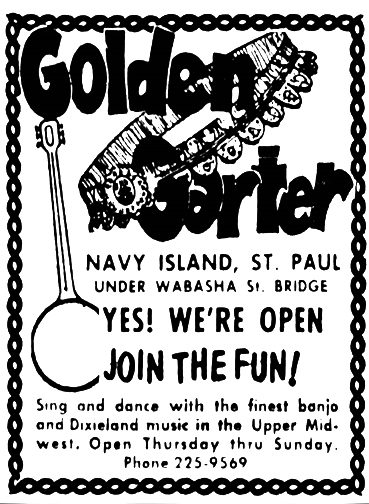
Minneapolis Tribune, June 16, 1966
The property was put up for sale in March 1967.
JIMMY’S ON THE LEVEE
This must have come from Facebook; if I’m quoting you and not giving you credit, please contact me.
In the spring of 1967, Jimmy Theros (Restaurant owner in St. Paul), Shirley Erdman (Insurance Executive) and Dave Wesley (Dentist/Banjoist) met for their customary lunch at Jimmy’s Highland Park Restaurant.
For the past few weeks they had been discussing re-opening the old Golden Garter restaurant. Dave had performed there in the early ’60s as leader of the Levee Loungers before going on to Diamond Jim’s, after which he retired from the music business to pursue his dentistry career full time.
Jimmy’s opened on November 3, 1967. Throughout its tenure it appeared to be open on Fridays and Saturdays only. The house band was Dave Wesley and his Barbary Coast Banjo Band.
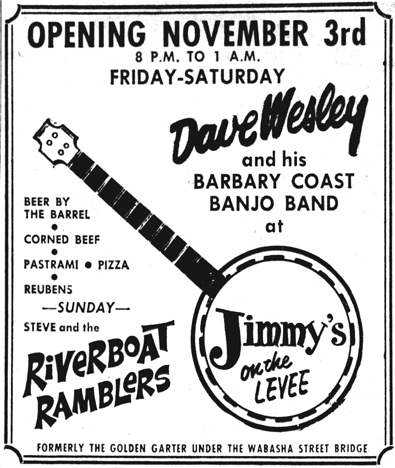
Minneapolis Star
Jimmy’s seemed to be plagued by stops and starts. No record of the first closing, but the first re-opening was on October 31, 1969.
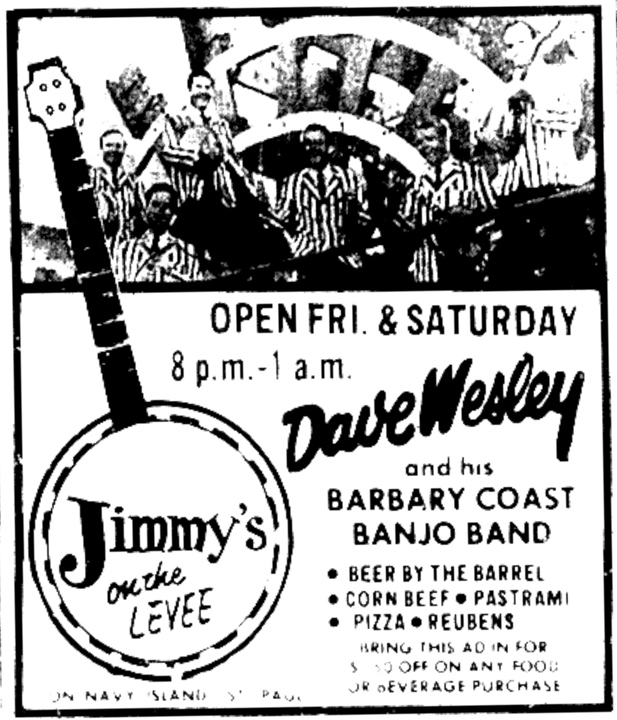
June 18, 1971
Jimmy’s on the Levee closed again on July 1, 1972.
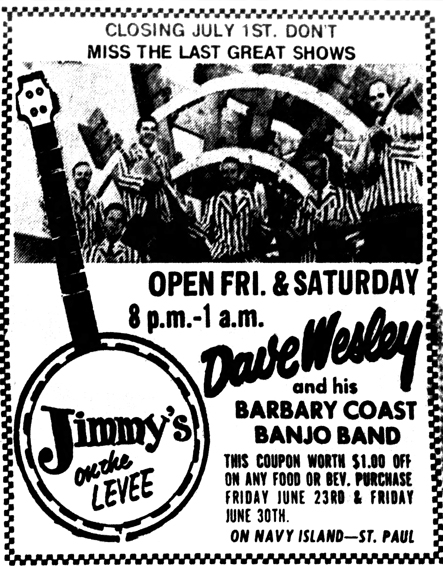
Minneapolis Star
But you can’t keep a good banjo down, and Jimmy’s re-opened yet again on October 27, 1972.
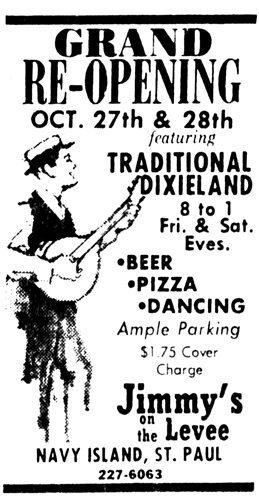
Minneapolis Star
But Jimmy’s finally gave up the ghost for good. Here’s the last ad I found:
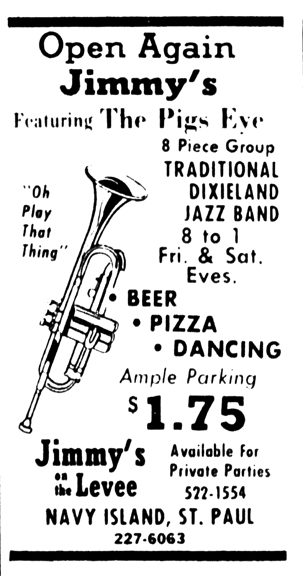
Minneapolis Tribune, November 24, 1972
THE RIVER SERPENT
Co-founder Jim Watson describes the beginning of the River Serpent:
I was hitchhiking back from San Francisco after finishing up playing with Dan Hicks. Jack Seel and Eddie Holmers, old friends, picked me up. The three of us opened the River Serpent in 1973 for $750 with aid from Ted Hamm of the Hamms Brewery. I was referred to as the Captain and sang, played, and drank there, as well as lived there, every day and night. I primarily put the bands together to sing with them. I never loved anything more. The music continued on and on with great Blues and jazz and is still spoken of with reverence and love!
A mention in the paper in September 1973 called the River Serpent “the new Sunday in-spot (on Marine Island).”
Jack Seel, a photographer, and Eddie Holmers, have both passed away.
Drummer Scott Sansby remembers that the stage was a good 12 feet above the dance floor, and we had to climb a ladder and go through a trap door to get up there.
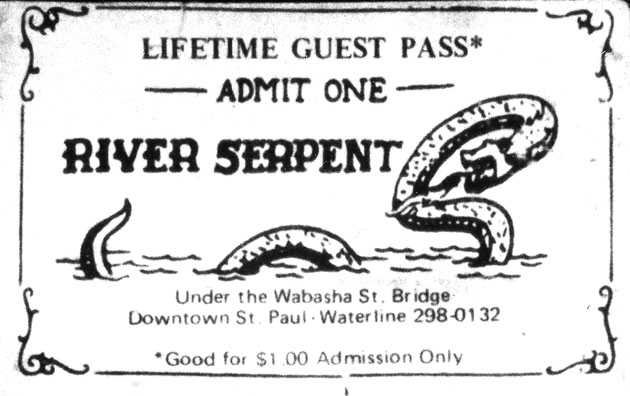
The Serpent was famous for its elaborate calendars, although the fabulous artists didn’t think to include the years for historians!
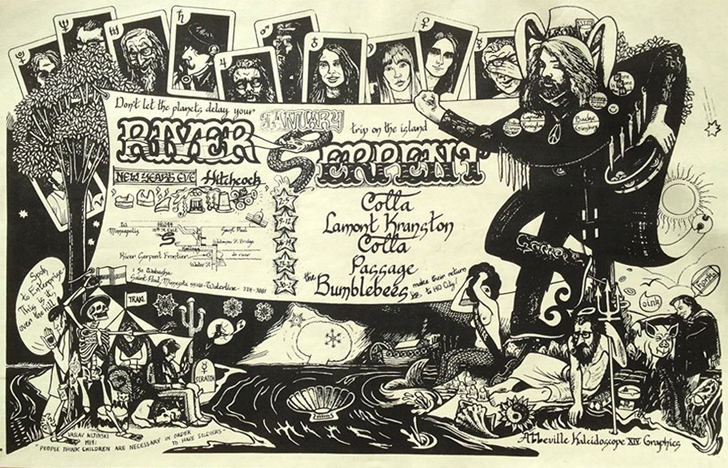
A January calendar courtesy Jim Watson
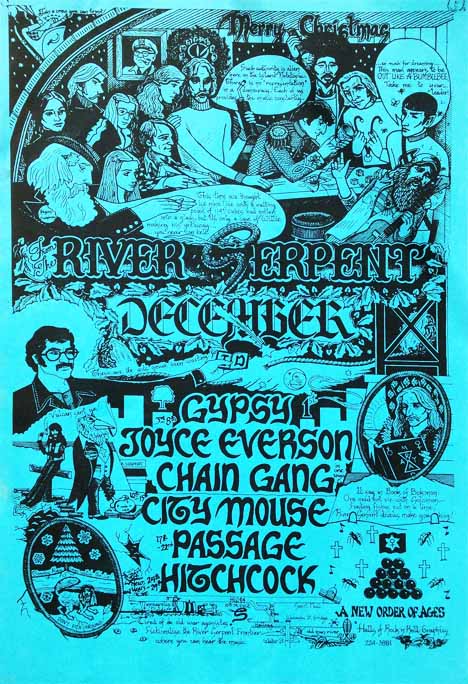
Poster courtesy Jim Watson
Mojo Buford Blues Band at the River Serpent, September 1974. Russ ” Bucko ” Williams on drums, Billy Black on bass, Dave “Cool Breeze” Brown.
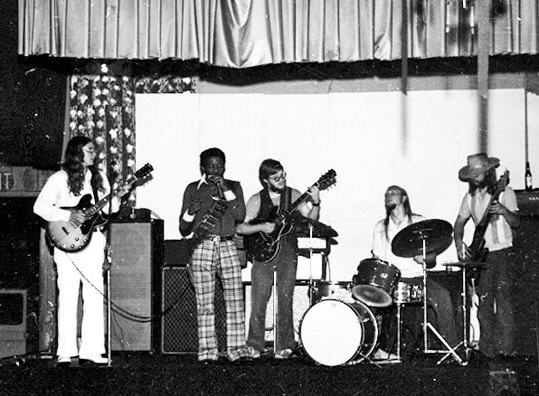
Photo courtesy Will Agar via Robb Henry.
The Shakey’s of Rock-and-Roll Bars?
In the September 1974 issue of the Insider, Dean J. Seal reviewed the August 17, 1974, performance of Passage at the River Serpent. At the time, Passage consisted of (as listed in the review):
- Scott Sansby on drums
- David Miner on bass
- Jody Brown on congas, described as the backbone of their sound
- Bobby “Kinky” Schnitzer on guitar
- Bruce “Creeper” Kurnow on electric piano and harmonica (often at the same time)
- Richard “Junior” Dworsky on organ and electric piano [later of “A Prairie Home Companion” fame]
- Doug Maynard on vocals
- Gwen Davis on vocals
Seal was kind of viscous in his review of the Serpent, alleging that the band had to compromise its talent to play dance music that was beneath them in order to eat. Anything they’d rather do had to be snuck into the song, which didn’t really work. This was probably true of any group of accomplished musicians (they say Sha-Na-Na warmed up by playing progressive jazz), but likening the River Serpent to Shakey’s was pretty harsh! (I wonder if he even knew about the place’s banjo past…)
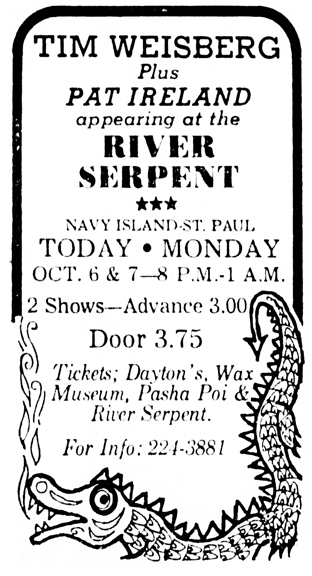
Minneapolis Tribune, October 1974
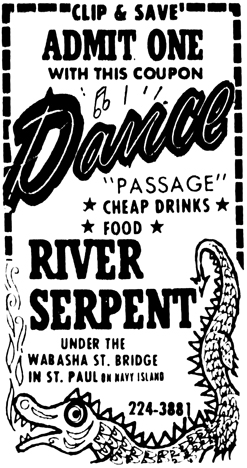
Minneapolis Tribune, January 12, 1975
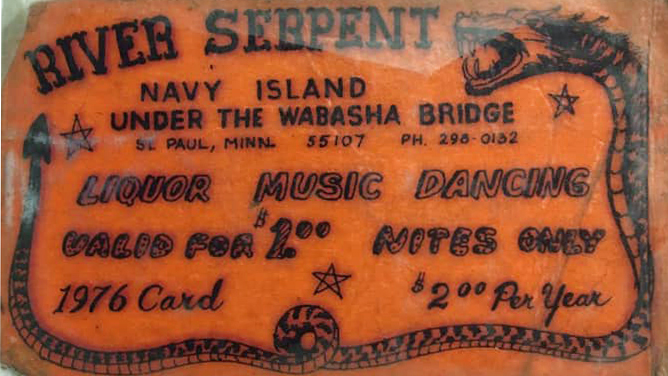
Bob Schmidt’s 1976 River Serpent admit card – $2/year!
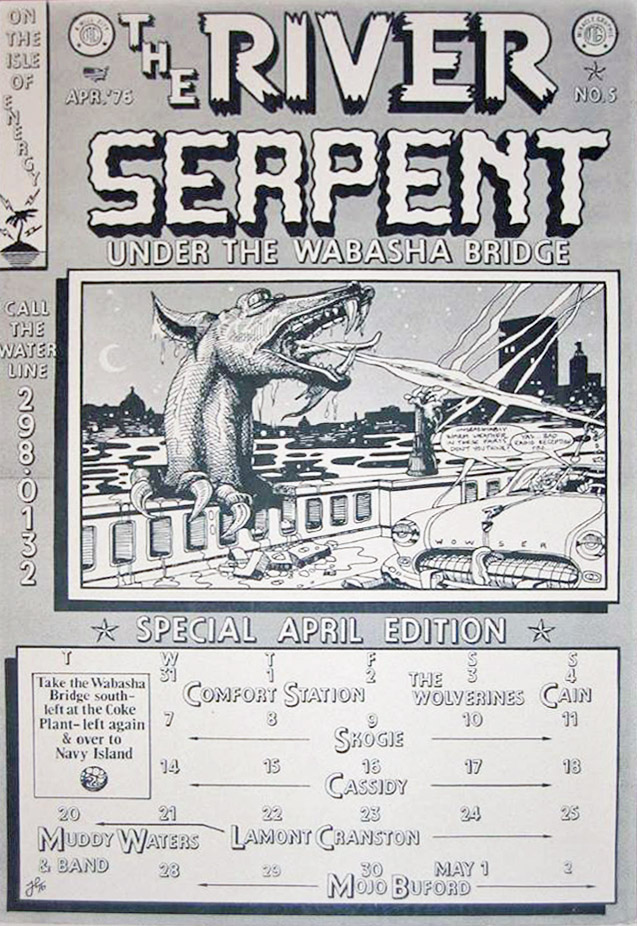
Calendar from April 1976 by Johnny Hanson, courtesy Rico Anderson
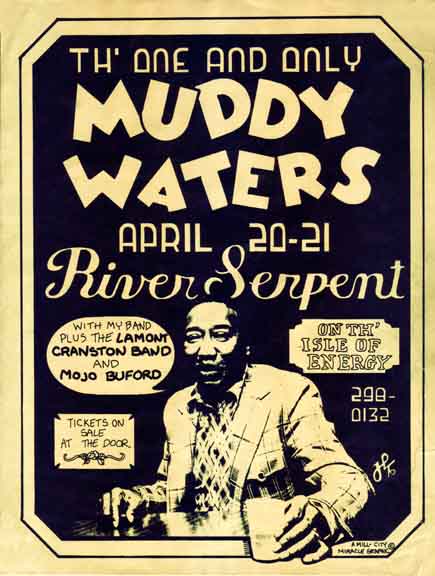
Muddy Waters poster by Johnny Hanson, courtesy Bob Fernow
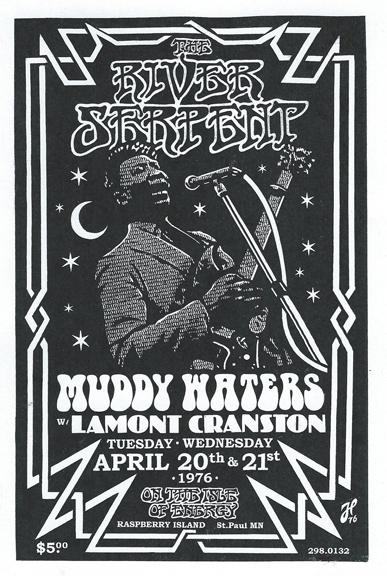
Muddy Waters II by Johnny Hanson, April 1976
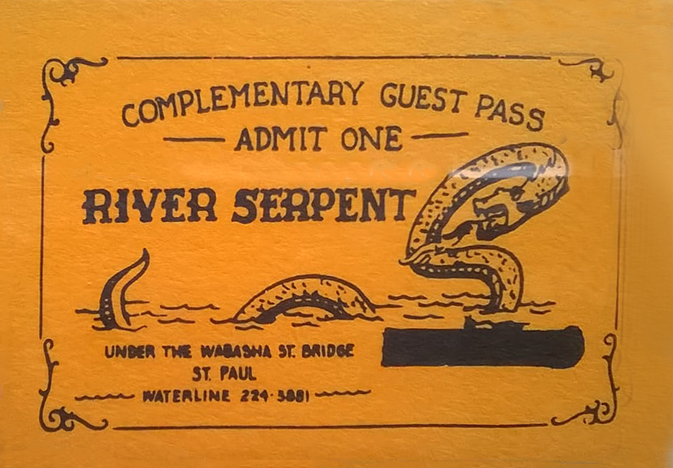
Guest Pass, courtesy Richard Anderson
My River Serpent Story
My one and only visit to the Serpent was on May 14, 1976. ‘Twas on that night that a 19-year-old Jeannie with a group of about 14 friends from the U of M took a ride on the Jonathan Paddelford, all dressed up in long dresses and suits and ties. That’s me, last girl on the right. (That guy on the far right was not my date!)
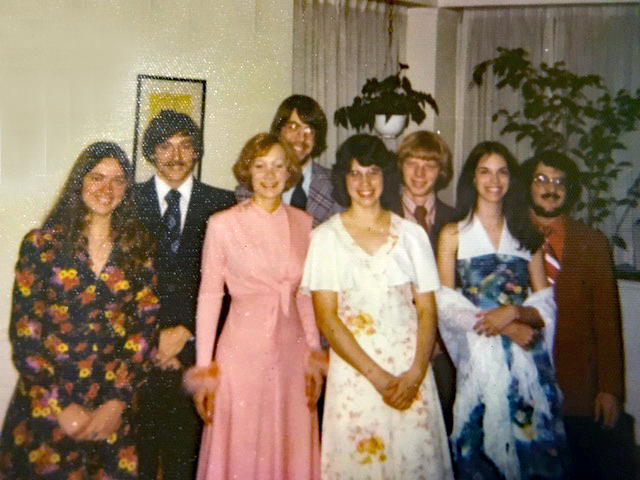
Photo courtesy Jan Linse Baldwin
From my journal I learned that we danced our butts off on the boat – everything from the Virginia Reel to the Bunny Hop. Afterwards, we somehow found ourselves at the River Serpent – how, I don’t know, since we were were all very broke and didn’t go to clubs. Anyway, we walked in, and the regulars were dressed in jeans and gave us the fish eye.
I sent this to four of my friends who were there, and although all these years I thought the band was Passage, Jim immediately remembered that it was Lamont Cranston. They were on a break when we got there, but we stood on the dance floor until they came back, and when they did, we just went nuts and danced our butts off some more! We loved to dance! I tore the hem out of my dress, it got so wild. It got hot in there, so we went “outside,” where ever that was, and continued dancing out there. It was the best band I’ve ever heard, and a night to remember always. Bless the River Serpent for a fabulous night!
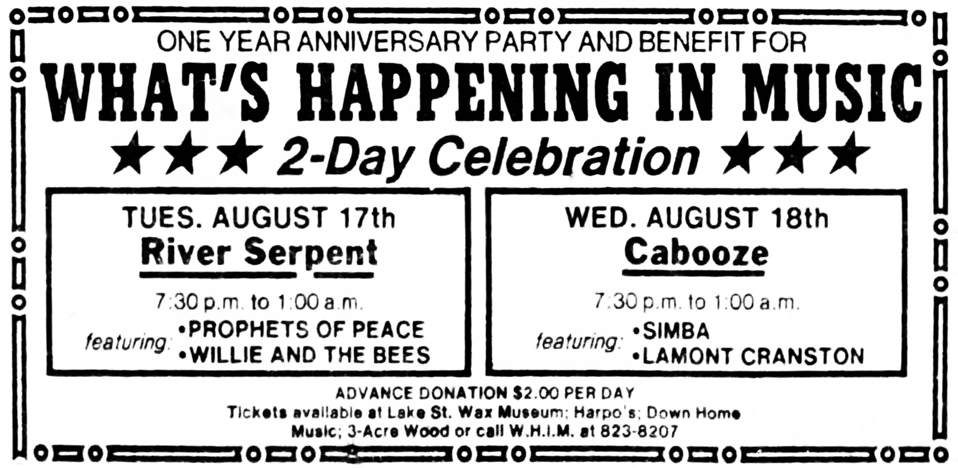
Minneapolis Tribune, 1976
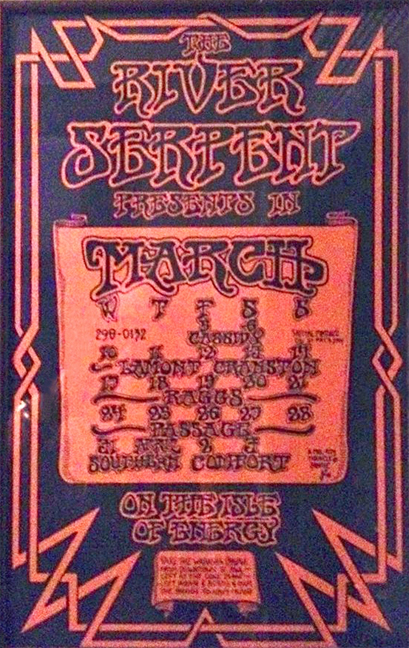
March, year unknown. “On the Isle of Energy”
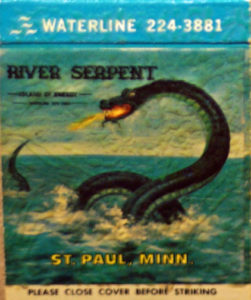
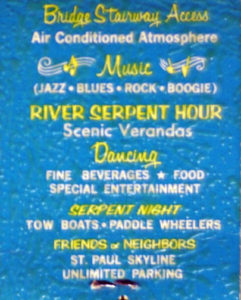
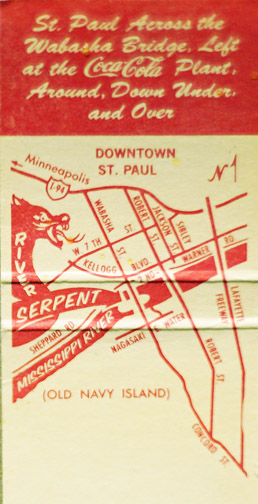
The last mention I found was in January 1977, when it was “closed for remodeling.”
ROCKIN’ ON THE RIVER
In the 1980s, the Island was the site of some major concerts.
The first was on May 21, 1983, and starred R.E.M. and the major local bands the Suburbs, the Replacements, and Phones.
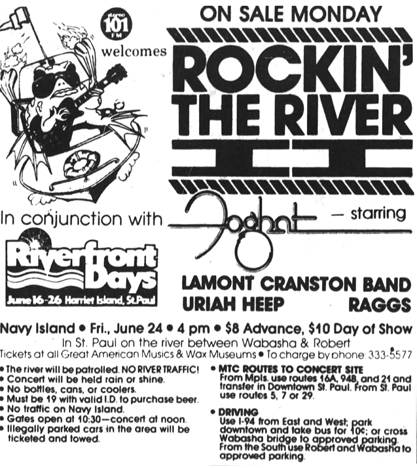
Minneapolis Tribune, June 5, 1983
In 1984 the series was expanded.
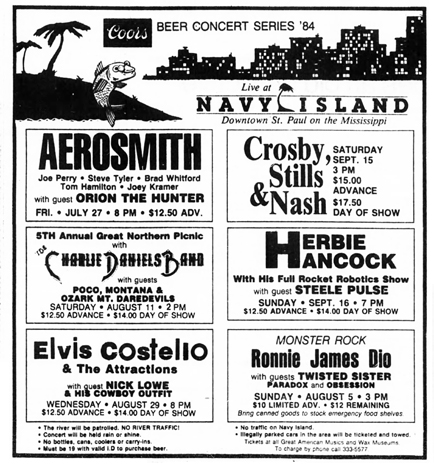
Minneapolis Tribune, July 22, 1984
The Navy Island concerts kind of petered out in 1984. The Elvis Costello concert was moved to the Orpheum, and CSNY was moved to the Minneapolis Auditorium. The Go-Gos had been added for September 9 but were then cancelled, as was Herbie Hancock. Only 7,000 people each came to see concerts by Aerosmith and .38 Special; Ronnie James Dio pulled 5,000, and perennial favorite Bonnie Raitt only drew 1,500. Promoter Randy Levy of Schon Productions said that the company suffered a six-figure loss. (Minneapolis Tribune, September 16, 1984)
The Boathouse is now a wedding venue as well as an active rowing club.
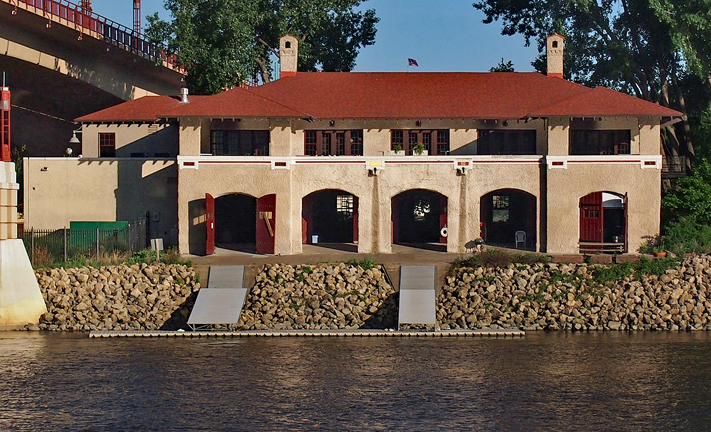
Boathouse in 2013
BUT THE BUILDING STILL FLOODS….

2019
